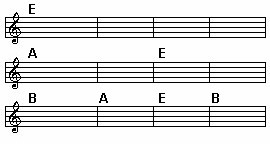Scroll through the lesson and click on notation/video/audio links to load the interactive players.
Please subscribe to get full access to all lessons for only $7.95/month PLUS 1 week free trial.

Riff Interactive lessons are
LESS expensive and
MORE interactive than alternatives!
More Info
|
|

Blues Guitar For
Beginners
Lesson 8
Lyle: Welcome to
another Blues lesson. This one has a cool solo made from the E minor blues
scale. But first it's a good idea to learn how to play the rhythm guitar part.
This is another 12 bar blues
progression:
chord
chart

Lyle: For the measures that have the E chord
you'll want to do this rhythm riff:
Lyle: I
like the sound of this riff. It reminds me of a ZZ Top song or
jam.
Lyle: You can use a clean tone or dirty tone. You
can even do this on an acoustic guitar.
Lyle: Take the E riff and move it down one string
to make it an A riff:
ZZ: Can I use the pinky for the 5th fret
instead?
Lyle:
Yes you can use the pinky for the 5th fret part of the
riff.
Lyle: The "E and A" rhythm licks use a power
chord made from root note and 5th degrees, then alternating between the 6th and
b7th degrees of the key before it comes back down.
Lyle:
During measures 9 and 10 you'll play this:
Lyle:
For the final 2 measures you'll play this next riff, also known as "the
turnaround riff":
Lyle:
Here's how all the rhythm parts go together for the complete 12
bars:
Lyle:
Play along to the TAB notation. Select the loop feature. Once you get it down
and can play right along with it, try playing along to this looping jam
track:
Lyle:
For most beginners this rhythm riff isn't too tough. With a little practice
you'll get it down in no time at all.
Lyle: The solo I've made for you to learn is a
different story. This solo will give some beginners something to work
at.
Lyle:
First learn the E minor blues scale in the open position:
Lyle:
Pay attention to which fingers you are using for this scale pattern. Many times
I see beginners using the wrong fingers. Look at the TAB playback on the virtual
neck to see the fingerings.
Lyle: The solo is made mostly from this scale. I
made the solo by repeating this riff here:
Lyle:
Notice the first note of the main riff has a slight bend to
it.
Lyle:
Here's the first solo with this main riff all through it. There will be a few
other "bonus" blues riffs mixed in there too:
mark: That riff
just doesn't sound the same on an acoustic! :-)
Lyle:
Play it hard and heavy if you're using an acoustic.
Lyle: Can I show you another solo that is just
like this one?
ZZ: Go for it!
Lyle: The minor blues scale is made from the
root, b3, 4, b5, 5, and b7 degrees of the major scale.
Lyle: The MAJOR blues scale is made from the
root, 2, b3, 3, 5, and 6 degrees of the major scale.
Lyle: I made you another solo from the E major
blues scale way up high on the neck:
Lyle:
Here is the solo. You'll be jumping around the neck and switching from the E
major and minor blues scales.
Lyle: For some beginners this solo will take extra
practice!
radica: Those
bends on the G string sound nice!
Lyle: Those are very important little
bends that help give you the blues
sound.
StevO: I dig the bends on the 9 and 10 what are
those called? are those chords?
Lyle: Those are just a couple notes from the A7
chord.
Lyle: That's all for this lesson. I hope this
gives you something good to practice for the week. See if you can memorize the
solos and then play them along to the looping jam track.
|
<< load notation from left
|
|
<< load audio from left
|
<< load audio from left
|